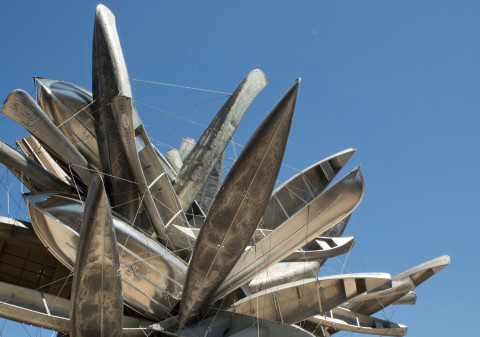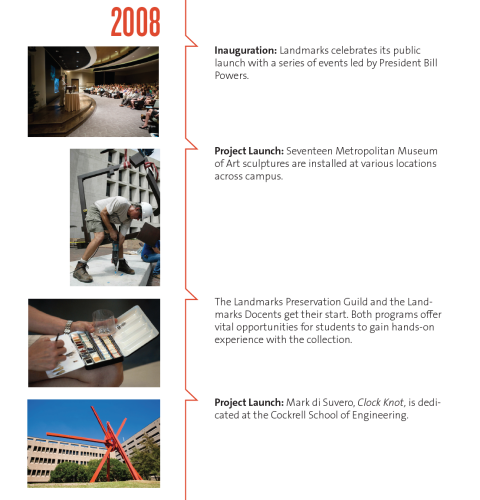Works of public art have the capacity to resonate deeply, stimulate curiosity, and inspire the imagination in unexpected ways. At The University of Texas at Austin, the public art collection is one of the most distinguishing features of the main campus, shaping impressions and offering a distinctive setting for memorable experiences.
As the university’s public art program, Landmarks enriches the lives of students and visitors by presenting art that is broadly accessible and free to all. Some fifty works of modern and contemporary art are throughout the 433-acre campus and viewed by thousands of people every day.
For many, the collection provides an introductory opportunity to discover great works of art. By creating equitable pathways to meaningful engagement, Landmarks reflects the complex audiences we serve and celebrates our differences.
Visit soon to discover why Landmarks is a point of pride for the university and all people of the State of Texas.
Landmarks' Mission
Landmarks inspires thought and growth by presenting public art at The University of Texas at Austin. We believe that great art should be free and accessible to all.
Landmarks' Commitment to Our Community
Believing that art fosters personal growth and human connection, Landmarks builds understanding through observation, interpretation, dialogue, and participation. Our work embraces the following principles to encourage meaningful engagement with public art:
- Welcoming all people.
- Recognizing and working to remedy inequities by creating opportunities that are just and fair.
- Inviting meaningful participation through collaborative and respectful environments.
- Providing pathways that mitigate barriers to engagement
Landmarks is led by its founding director and curator Andrée Bober, who oversees the development of the collection and a vibrant range of programs that support scholarship and learning. She reports to the dean of the College of Fine Arts and works closely with the Landmarks Advisory Committee, the Office of the Senior Vice President and Chief Operating Officer, the Office of the Vice President and Chief Financial Officer, and the Office of the Executive Vice President and Provost.
Sonya Berg, assistant to the director
Andrée Bober, founding director and curator
Kathleen Brady Stimpert, deputy director
Anoush Crane, event coordinator
Kanitra Fletcher, Landmarks Video curator
Bill Haddad, technology manager
Dorothy Lin, graphic designer
An Phung, digital content coordinator
Thao Votang, business coordinator
Jo Roznovsky, education program coordinator
Stephanie Taparauskas, assistant director for development
Please send an email to Landmarks staff.
Landmarks has its origins in a policy for Art in Public Spaces that was approved in 2005 by The University of Texas System Office of the General Counsel and the Executive Vice Chancellor for Academic Affairs. The policy sets aside 1-2 percent of capital improvement projects to acquire public art. Considerations for participating projects include the location and purpose of the building, its overall budget, and the extent to which it includes public spaces. While this policy funds the acquisition of public art on campus, ongoing operations such as conservation and education programs are supported by private contributions.
A broad range of criteria guide project selections that include, but are not limited to:
- Artistic merit (quality, condition, rarity, provenance)
- Quality of presentation in architectural and/or landscape setting
- Stature of artist in the critical arts community
- Offers meaningful opportunities for community engagement
- Art historical merit
- Relevance to art history and other curricula
- Relation to other works in Landmarks collection
- Support public art master plan
- Contribution to cultural environment
- Feasibility of installation and cost
- Feasibility of care and maintenance
- Durability of work
- Safety and disability standards
Each project is reviewed and endorsed by a team of specialists and community stakeholders. Landmarks convenes a standing advisory committee to consider upcoming building projects, evaluate artists for the public art component, and endorse specific proposals. The current advisory committee includes:
- Andrée Bober, founding director and curator of Landmarks
- Dr. C. Ondine Chavoya, chair of the Committee for the Review of Art
- George Flaherty, professor of Art History
- Scherezade Garcia-Vazquez, professor of Art
- Jana La Brasca, graduate student in Art History
- Kevin Alter, professor of Architecture
- John Stoney, professor of Art
- Phillip Townsend, curator of Art Galleries at Black Studies
Landmarks oversees works of art in its collection, but does not manage all public art or creative projects on the university's campus. Proposals for public art and other creative projects are evaluated by the Committee for the Review of Art (CRA). To help facilitate approvals, the CRA provides the following guidelines:
Understanding Creative Projects
https://landmarks.utexas.edu/sites/default/files/2025-02/cra_policy_understanding-creative-projects.pdf
Proposal Guidelines for Creative Projects
https://landmarks.utexas.edu/sites/default/files/cra_policy_proposal-guidelines.pdf
Checklist for Permanent Creative Projects
https://landmarks.utexas.edu/sites/default/files/cra_policy_project-checklist.pdf
Checklist for Temporary Creative Projects
https://landmarks.utexas.edu/sites/default/files/cra_policy_temp-project-checklist.pdf
Peter Walker Partners created a Public Art Master Plan (pdf) to ensure a comprehensive approach to building a collection of public art. The plan corresponds to the 1999 César Pelli Campus Master Plan and it serves to guide overall public art acquisition and placement. Among many considerations, it proposes the best locations for installations of public art to provide visual anchors at gateways, to accentuate main axis corridors, and to delineate architectural edges.
PERSONAL USE
The public may take pictures of Landmarks’ works for personal use, inclusion on individual social media accounts, and for other non-commercial purposes. Please tag (@landmarksut) or otherwise credit Landmarks when possible.
EDUCATIONAL USE
University students, faculty, and staff may include images of Landmarks’ works in educational, non-commercial materials. Images may be downloaded directly from the website. A selection of images is also available through ArtStor. Please include captions with any presentation of these images.
COMMERCIAL USE
The University of Texas at Austin and its affiliates enjoy a limited right to reproduce images of Landmarks’ projects for educational and promotional purposes. The university does not own the copyright to these works and it may not reproduce these images for commercial purposes. Any party who seeks to reproduce art in the Landmarks collection for commercial gain must first obtain permission from the copyright holder, which typically belongs to the artist or the artist’s estate.
Photography requests for commercial purposes are considered on a case-by-case basis and not every request can be approved. To make a request, please complete this form and a member of Landmarks’ staff will review and respond within five business days. Approved photography must include an image credit which will be provided by Landmarks.
PRESS
Members of the media may access Landmarks' press materials, works from its collection, and Landmarks Video on Landmarks’ Press Page. For high resolution images, please email info@landmarksut.org.
Beyond visiting the works of art and learning about them, students may support Landmarks by volunteering their time and expertise as a Landmarks Docent or member of the Landmarks Preservation Guild. Faculty members are encouraged to include Landmarks projects in curricula and schedule class tours.


